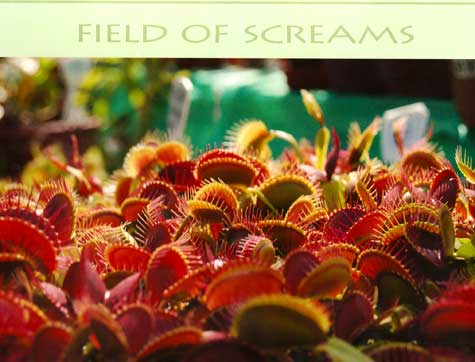 TRAPPED It’s meal time. |
On display behind a glass enclosure at the New England Carnivorous Plant Society's seventh annual show, held at the Botanical Center at Roger Williams Park in Providence September 26 and 27, was a rare book, not a plant: a first edition of Charles Darwin, in which Darwin stated that he "cared more about the round-leafed sundew (drosera rotundifolia) than any other."
Darwin, according to the society's president, John Phillip, Jr., was "fascinated that the sundew moved, attracted, killed, dissolved, and ate insects."
Most of the 500 hundred or so visitors who attended the show last weekend seemed to share Darwin's fascination with the carnivorous plants -- including hundreds of Venus flytraps, pitcher plants, sundews and corkscrews on display. The plants, unlike the book, were on full, open-air display, with admirers -- from young children to grandmothers -- ogling the fearsome teeth of the pitcher plants' mouths and the quick-closing mouths of flytraps.
Phillips, who said he had been growing carnivorous plants since 1974, proudly pointed out a huge tropical pitcher plant, nepenthes hamata, native to Indonesia, with 10-inch pitchers, which he said, "sits outside my house in Narragansett from April until September. It requires full sun and lots of water."
The genus of the tropical species, he explained, nepenthes, is named for a drug that Helen of Troy imbibed in Homer's Odyssey. According to Phillip, the translation as it applies to plants means, "without remorse ? the plants kill their prey without remorse."
One of the more amazing displays was a huge "bog bowl" filled with hundreds of Venus flytraps, grown by master grower Jeff Matteson, a veritable death wish for insects. The society created a poster of the magnificent plant display, entitled, "Field of Screams."
The growers of the carnivorous plants, members of the society, were as fascinating as the plants they displayed -- intense, dedicated, persistent, and fun-loving, taking great delight in growing the hard-to-grow plants.
Nicole Syrlik, from Kingston, New York, said that she had been growing carnivorous plants for 40 years. Outside the show, in the parking lot, she was generously giving some of her plants to David Schloat, the treasurer of the North American Sarracenia Conservancy based in North Salem, New York.
The sarrancenia genus is native to America, and grows in bogs, characterized by hollow, pitcher-shaped or tubular leaves and solitary flowers with an umbrella-shaped style.
Syrlik's rationale for her generosity: "I needed to make room for more plants." Schloat, in turn, was fascinated by the potential of creating hybrids. He was looking for a "bris" sarracenia, a plant with a shortened umbrella.
According to Phillip, there are 12 to 14 carnivorous plants that grow in bogs in Rhode Island, and the society regularly sponsors bog walks in the Great Swamp. Another successful outreach effort is working with third-grade classes throughout Rhode Island, lending them carnivorous plants to study.
In the next glassed-in greenhouse over, caterers were busy setting up for a wedding, prepping what appeared to be a well-stocked bar for the celebration. It didn't take much to imagine the possibility of some drunken guests wandering past the "caution" signs posted for the carnivorous plant show and begetting a new little shop of horrors.